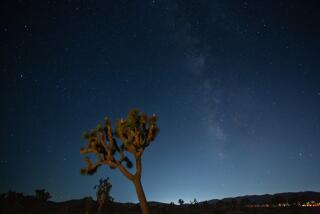Science / Medicine : New Technology Helps Astronomers Clear the Air
- Share via
Even on a clear night, the Earth’s atmosphere can lead an astronomer to despair.
Like the heat waves that distort a distant image when viewed over a hot highway, the atmosphere of the Earth causes stars to jump around, blurring images on even the best of telescopes. Atmospheric disturbance is why astronomers want to have their telescopes in orbit above the atmosphere, and it was a prime reason for building the billion-dollar-plus Hubble Space Telescope, scheduled for launch next year.
But during the years that Space Telescope has been sitting in a warehouse in Sunnyvale, waiting for a much-delayed launch, scientists have been busy figuring out how to reduce the distortion that afflicts ground-based instruments.
Caltech officials recently released these photos that dramatically illustrate how much progress has been made. The photo that looks like a big glob of fuzzy light is actually two distant stars, called a binary system, as seen through the 200-inch Hale Telescope at Palomar Observatory, the largest telescope in the country. The second photo, clearly showing both stars, was also shot with the Hale, but after it was equipped with instruments designed to reduce atmospheric distortion.
The second photo represents an improvement that is 20 times better than the telescope’s normal, clear-night resolution. The same technology will be applied to the Keck Telescope, which Caltech and the University of California are building on top of Mauna Kea in Hawaii. The Keck will be the world’s largest telescope, and the new technology will make its images at least twice as sharp as the maximum resolution that is even theoretically possible with the Hale.
The new techniques are called non-redundant masking and fully filled aperture. They first use a mask with seven pinholes to screen the image, in effect turning the large telescope into seven smaller scopes. Then, by using a supercomputer, scientists can sort out the differences between the seven “snapshots” and remove distortions caused by the atmosphere.
Masking reduces the amount of light collected by the telescope, so this process is best when viewing a very bright object. For objects that are more faint, the fully filled aperture technique is used.
Normally, a telescope takes long time exposures--sometimes running for hours--in order to collect enough light. But that increases its susceptibility to atmospheric disturbances because the air above the telescope constantly changes.
So instead of taking one very long exposure, the fully filled aperture method takes many very short snapshots with a “shutter speed” of 15 to 30 thousandths of a second. Once again, the supercomputer sorts through the images to come up with a clear photo.
The irony in all this is that the improvement that Space Telescope was to offer over ground-based instruments is rapidly being eroded. However, the orbiting instrument will still have one major advantage: It will be able to study the sky at wavelengths that cannot penetrate the atmosphere, thus imaging a universe that no ground-based telescope can see.






